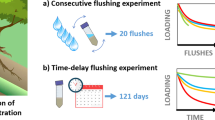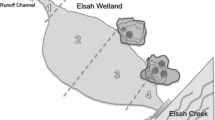Abstract
To assess the potential for treated wastewater irrigation to impact levels of fecal indicator bacteria (FIB) and salinity in irrigated soils, levels of Escherichia coli, Enterococcus, and environmental covariates were measured in a treated wastewater holding pond (irrigation source water), water leaving the irrigation system, and in irrigated soils over 2 years in a municipal parkland in Arizona. Higher E. coli levels were measured in the pond in winter (56 CFU 100 mL−1) than in summer (17 CFU 100 mL−1); however, in the irrigation system, levels of FIB decreased from summer (26 CFU 100 mL−1) to winter (4 CFU 100 mL−1), possibly related to low winter water use and corresponding death of residual bacteria within the system. For over 2 years, no increase in FIB was found in irrigated soils, though highest E. coli levels (700 CFU g−1 soil) were measured in deeper (20–25 cm) soils during summer. Measurements of water inputs vs. potential evapotranspiration indicate that irrigation levels may have been sufficient to generate bacterial percolation to deeper soil layers during summer. No overall increase in soil salinity resulting from treated wastewater irrigation was detected, but distinct seasonal peaks as high as 4 ds m−1 occurred during both summers. The peaks significantly declined in winter when surface ET abated and more favorable water balances could be maintained. Monitoring of seasonal shifts in irrigation water quality and/or factors correlated with increases and decreases in FIB will aid in identification of any public health or environmental risks that could arise from the use of treated wastewater for irrigation.
Similar content being viewed by others
References
Aiello, R., Cirelli, G. L., & Consoli, S. (2007). Effects of reclaimed wastewater irrigation on soil and tomato fruits: A case study in Sicily (Italy). Agricultural Water Management, 93, 65–72.
Alam, S. M. (1994). Nutrient uptake by plants under stress conditions. In M. Pessarakli (Ed.), Handbook of plant and crop stress (pp. 227–243). New York: Marcel Dekker.
Al-Nakshabandi, G. A., Saqqar, M. M., Shatanawi, M. R., Fayyad, M., & Al-Horani, H. (1997). Some environmental problems associated with the use of treated wastewater for irrigation in Jordan. Agricultural Water Management, 34, 81–94.
Alonso, M. C., Dionisio, L. P. C., Bosch, A., Pereira de Moura, B. S., Garcia-Rosado, E., & Borrego, J. J. (2006). Microbiological quality of reclaimed water used for golf courses’ irrigation. Water Science and Technology, 54(3), 109–117.
Anderson, E. L., Pepper, I. L., & Kneebone, W. R. (1981). Reclamation of wastewater with a soil-turf filter: I. Removal of nitrogen. Journal Water Pollution Control Federation, 53, 1402–1407.
Arizona Meteorological Network (AZMET) (2009). www.ag.arizona.edu/azmet/. Accessed 05 March 2010.
Assadian, N. W., Di Giovanni, G. D., Enciso, J., Iglesias, J., & Lindemann, W. (2005). The transport of waterborne solutes and bacteriophage in soil subirrigated with a wastewater blend. Agriculture, Ecosystems & Environment, 111, 279–291.
Bogosian, G., Sammons, L. E., Morris, P. J. L., O’Neil, J. P., Heitkamp, M. A., & Weber, D. B. (1996). Death of the Escherichia coli K-12 strain W3110 in soil and water. Applied and Environmental Microbiology, 62, 4114–4120.
Bovallius, A., Bucht, B., Roffey, R., & Anas, P. (1978). Long-range air transmission of bacteria. Applied and Environmental Microbiology, 35, 1231–1232.
Brown, P. W. (2005). Standardized reference evapotranspiration: A new procedure for estimating reference evapotranspiration in Arizona. University of Arizona Cooperative Extension Publication AZ1324. http://www.cals.arizona.edu/pubs/water/az1324.pdf. Accessed 05 March 2010.
Chakrabarti, C. (1995). Residual effects of long-term land application of domestic wastewater. Environment International, 21, 333–339.
City of Maricopa, Arizona (2009). http://www.maricopa-az.gov/. Accessed 28 February 2010.
Clesceri, L. S., Greenberg, A. E., & Eaton, A. D. (Eds.). (1998). Standard methods for the examination of water and wastewater (20th ed.). Baltimore: United Book Press.
Devitt, D. A., Lockett, M., Morris, R. L., & Bird, B. M. (2007). Spatial and temporal distribution of salts on fairways and greens irrigated with reuse water. Agronomy Journal, 99, 692–700.
Fine, P., & Hass, A. (2007). Role of organic matter in microbial transport during irrigation with sewage effluent. Journal of Environmental Quality, 36, 1050–1060.
Foght, J., & Aislabie, J. (2005). Enumeration of soil microbes. In R. Margesin & F. Schinner (Eds.) Soil biology, Vol. 5, (pp. 261–280). Heidelberg: Springer.
Griffin, D. N. (1985). A comparison of the roles of bacteria and fungi. In Leadbetter, E. R., & Poindexter, J. S. (Eds.) Bacteria in nature (pp. 221–255). New York: Plenum.
Gunes, A., Inal, A., & Alpaslan, M. (1996). Effect of salinity on stomatal resistance, proline, and mineral composition of pepper. Journal of Plant Nutrition, 19, 389–396.
Heidarpour, M., Mostafazadeh-Fard, B., Abedi Koupai, J., & Malekian, R. (2007). The effects of treated wastewater on soil chemical properties using subsurface and surface irrigation methods. Agricultural Water Management, 90, 87–94.
Howell, J. M., Coyne, M. S., & Cornelius, P. L. (1996) Effect of sediment particle size and temperature on faecal bacteria mortality rates and the faecal coliform/faecal streptococci.
Lang, N. L., Smith, S. R., Bellett-Travers, D. M., Pike, E. B., & Rowlands, C. L. (2007). Decay of Escherichia coli in soil following the application of biosolids to agricultural land. Water Environment Journal, 17, 23–28.
Lighthart, B. (1984). Microbial aerosols: Estimated contribution of combine harvesting to an airshed. Applied and Environmental Microbiology, 47, 430–432.
Luh, W. M., & Guo, J. H. (2001). Using Johnson’s transformation and robust estimators with heteroscedastic test statistics: An examination of the effects of non-normality and heterogeneity in the non-orthogonal two-way ANOVA design. The British Journal of Mathematical and Statistical Psychology, 54(Pt 1), 79–94.
Magesan, G. N., Williamson, J. C., Yeates, G. W., & Lloyd-Jones, A. R. H. (2000). Wastewater C:N ratio effects on soil hydraulic conductivity and potential mechanisms for recovery. Bioresource Technology, 71, 21–27.
Mancino, C. F., & Pepper, I. L. (1997). Irrigation of turfgrass with wastewater. In U.S. Golf Association (Ed.) Wastewater reuse for golf course irrigation (pp. 221–255). Boca Raton: Lewis.
Mawdsley, J. L., Bardgett, R. D., Merry, R. J., Pan, B. F., & Theodorou, M. K. (1995). Pathogens in livestock waste, their potential for movement through soil and environmental pollution. Applied Soil Ecology, 2, 1–15.
McCambridge, J., & McMeekin, T. A. (1980). Relative effects of bacteria and protozoan predators on survival of E. coli in estuarine water samples. Applied and Environmental Microbiology, 40, 907–911.
McKeon, C., Glenn, E., Gerba, C. P., & Fitzsimmons, K. (2000). Microbiological hazards of tilapia culture systems. In Fitzsimmons, K., & Filho, J. C. (Eds.) Proceedings of the Fifth International Symposium on Tilapia Aquaculture (pp. 479–485). Brazil: Rio de Janiero.
Moe, C. I. (2002). Waterborne transmission of infectious agents. In Hurst, C. J. (Ed.) Manual of environmental microbiology (pp. 184–204). Washington, DC: American Society for Microbiology.
O’Connor, G. A., Elliott, H. A., & Bastian, R. K. (2008). Degraded water reuse: An overview. Journal of Environmental Quality, 37, S157–S168.
Oron, G., Armon, R., Mandelbaum, R., Manor, Y., Campos, C., Gillerman, L., et al. (2001). Secondary wastewater disposal for crop irrigation with minimal risks. Water Science and Technology, 43, 139–146.
O’Toole, J., Sinclair, M., Diaper, C., & Leder, K. (2008). Comparative survival of enteric indicators, E. coli and somatic and F-RNA bacteriophages on turf-grass irrigated with recycled water. Water Science and Technology, 58(3), 513–518.
Palese, A. M., Pasquale, V., Celano, G., Figliuolo, G., Masi, S., & Xiloyannis, C. (2009). Irrigation of olive groves in Southern Italy with treated municipal wastewater: Effects on microbiological quality of soil and fruits. Agriculture, Ecosystem and Environment, 129, 43–51.
Papadopoulos, F., Parissopoulos, G., Papadopoulos, A., Zdragas, A., Ntanos, D., Prochaska, C., et al. (2009). Assessment of reclaimed municipal wastewater application on rice cultivation. Environmental Management, 43, 135–143.
Pepper, I. L., & Mancino, C. F. (1993). Irrigation of turf with effluent water. In Pessarakli, M. (Ed.) Handbook of plant and crop stress (pp. 623–641). New York: Marcel Dekker.
Post, D. F., Mack, C., Camp, P. D., & Suliman, A. S. (1988). Mapping and characterization of the soils on the University of Arizona Maricopa Agricultural Center. Journal of the Arizona-Nevada Academy of Science, 18, 49–60.
Qian, Y. L., & Mecham, B. (2005). Long-term effects of recycled wastewater irrigation on soil chemical properties on golf course fairways. Agronomy Journal, 97, 707–721.
Ramirez-Fuentes, E., Lucho-Constantino, C., Escamilla-Silva, E., & Dendooven, L. (2002). Characteristics, and carbon and nitrogen dynamics in soil irrigation with wastewater for different lengths of time. Bioresource Technology, 85, 179–187.
Sampson, R. W., Swiatnicki, S. A., Osinga, V. L., Supita, J. L., McDermott, C. M., & Kleinheinz, G. T. (2006). Effects of temperature and sand on E. coli survival in a northern lake water microcosm. Journal of Water and Health, 04(3), 389–393.
Sidhu, J. P. S., Hanna, J., & Toze, S. G. (2008). Survival of enteric microorganisms on grass surfaces irrigated with treated effluent. Journal of Water and Health, 06(2), 255–262.
Smith, E., & Hegazy, S. (2006). E. coli transport in soil columns: Implications for reuse of treated wastewater in irrigation. Water Science and Technology, 54, 175–182.
Thomas, J. C., White, R. H., Vorheis, J. T., Harris, H. G., & Diehl, K. (2006). Environmental impact of irrigating turf with Type I recycled water. Agronomy Journal, 98, 951–961.
US Environmental Protection Agency (USEPA) (2004). Guidelines for Water Reuse. http://epa.gov/nrmrl/pubs/625r04108/625r04108.pdf. Accessed 08 March 2010.
Vogeler, I. (2009). Effect of long-term wastewater application on physical soil properties. Water, Air, and Soil Pollution, 196, 385–392.
Wade, T. M., Pai, N., Eisenberg, J. N., & Colford, J. M., Jr. (2003). Do US Environmental Protection Agency water quality guidelines for recreational waters prevent gastrointestinal illness? A systematic review and meta-analysis. Environmental Health Perspectives, 111, 1102–1109.
Winfield, M. D., & Groisman, E. A. (2003). Role of nonhost environments in the lifestyles of Salmonella and Escherichia coli. Applied and Environmental Microbiology, 69, 3687–3694.
Author information
Authors and Affiliations
Corresponding author
Rights and permissions
About this article
Cite this article
McLain, J.E.T., Williams, C.F. Assessing environmental impacts of treated wastewater through monitoring of fecal indicator bacteria and salinity in irrigated soils. Environ Monit Assess 184, 1559–1572 (2012). https://doi.org/10.1007/s10661-011-2060-4
Received:
Accepted:
Published:
Issue Date:
DOI: https://doi.org/10.1007/s10661-011-2060-4




